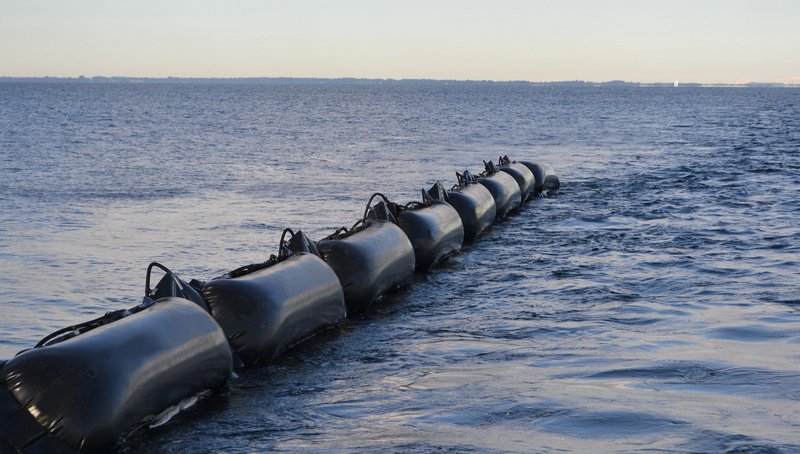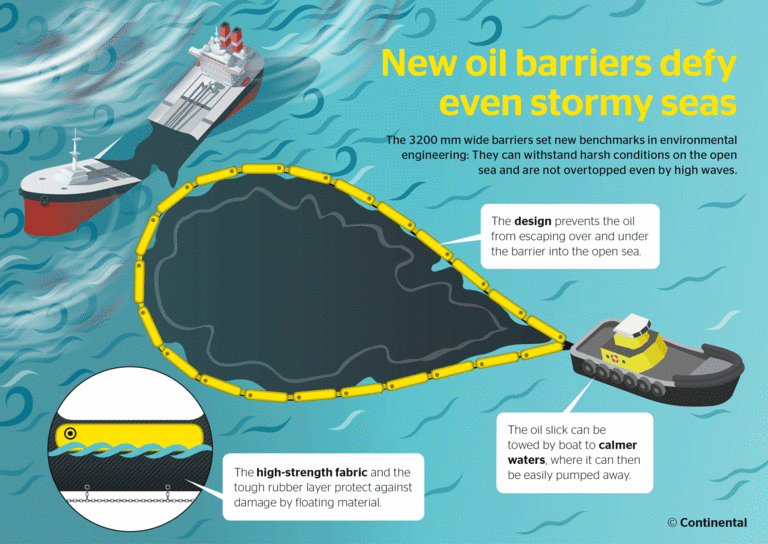Continental Sets New Standards on the High Seas with an Effective Floating Oil Barrier
- The hand-made oil barriers from Continental not only protect the environment but also reliably contain oil spills even in turbulent seas
Hanover, October 10, 2018. The technology company Continental has developed a new generation of floating oil barriers for use on the high seas. With a width of 3200 mm, they are especially suitable for use on rough seas.
The energy requirements around the world mean an increase in the amount of crude oil transported by sea. This also brings an increase in the risk of accidents entailing considerable impact on the environment as well as on a company’s profitability – both during pumping on the drilling rigs and in the event of maritime disasters involving damage to giant tankers. In collaboration with a partner, the technology company Continental has now developed a highly effective protective measure: a new type of floating oil barrier that can withstand even Arctic storms. The floating barriers are used during regular maintenance for oil drilling rigs as well as in emergency situations because, despite stringent safety measures, accidents on the high seas cannot be completely avoided. Following incidents and accidents, immediate action is essential in order to minimize the extent of the resulting oil slick. The floating barriers surround leaked oil at sea so that tankers can quickly pump it out of the water using hoses. Depending on the swell, this takes place directly at the deployment site or in more moderate waters with smaller waves.
The method of surrounding oil in this way is not new, and the floating barriers have also proven themselves for many years in serial use during maintenance work on oil drilling rigs. However, the latest generation of the oil barrier has a special feature to offer. “What makes it so unique is the special width of the air bags: Products commonly found on the market measure no more than 2000 mm. For production- and material-related reasons, it was previously not possible to manufacture this product with other dimensions. With our 3200-mm-wide barriers, we are setting new standards in environmental technology,” said Michael Möschen, an application engineer at Continental. With this development, Continental has succeeded in creating oil barriers that can withstand even heavy fall storms, while conventional designs with a width of just 2000 mm are quickly washed over in heavy swell – with catastrophic consequences for the environment.
Tailor-made environmental technology
The devastating sinking of the Deepwater Horizon in the Gulf of Mexico in April 2010 showed that much wider barriers are needed for reliably containing an oil slick. As a result, the number of inquiries for appropriate solutions increased and work to develop even wider barriers began.
“We are very well positioned in terms of product strategy, and even then our vulcanization process was sufficiently advanced. Production was a real challenge that we successfully overcome. We have since already delivered several of these 3200-mm-wide oil barriers, but of course only after they had successfully undergone testing in heavy storms with meter-high waves,” said Michael Möschen describing the successful project.
The latest generation of the oil barrier is made, assembled and vulcanized at the Continental plant in Northeim. Like the conveyor belts, the manufacture of which has been a specialism of Continental for decades, it is made from rubber and various fabric layers. There is simply no alternative fabric on the market in the required size, which means that the separating layers of the individual pieces of fabric have to be joined together when the oil barriers are being made. The particular challenge during production is therefore the manual assembly of the floating barriers, which makes the production process extremely laborious. On top of that, the units and presses have to work with extreme precision. “The oil barriers have extremely thin walls for their width – no more than 6–7 mm. When they are shipped to the deployment site, they are coiled on strong winches. Every single kilogram counts and so the mass should be kept as low as possible,” added Möschen.
Strength in the face of adversity on the high seas
Tested under special test conditions and at sea, the floating barriers have proven themselves to be extraordinarily reliable and secure. In terms of width, they are unrivaled on the market. To ensure that the barriers remain vertical in the water, chains with weights on them are attached below the water’s surface. This prevents even thick layers of oil from floating into the open sea under the barrier and ensures instead that the oil is reliably contained.
The development team also paid particular attention to strength. Flotsam in the sea can damage the floating barriers. The high-strength fabric and sturdy rubber layer of this Continental development is extremely impressive in this respect, too, withstanding pressures of up to 0.5 bar in the laboratory. That sounds modest, but it is enormous for an air bag of this size. And another aspect is important: The barriers are airtight like a bicycle inner tube – after all, no air must be allowed to escape during deployment. Air is pumped into the barriers as soon as they are lowered into the water by the winch on the ship.

Sébastien Bonset
Media & PR Manager, Media Coordination APAC
ContiTech


